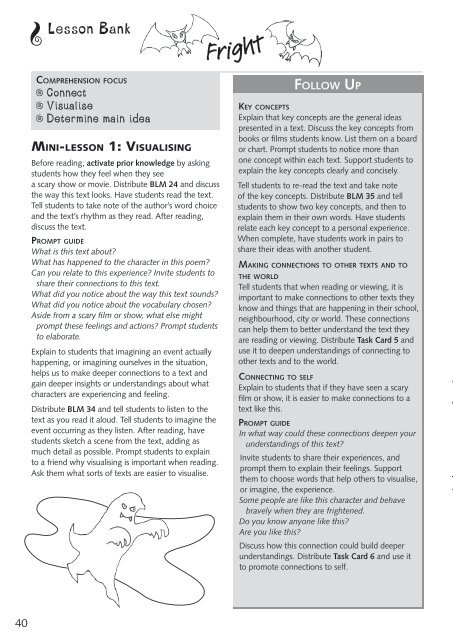All You Need To Teach Comprehension 10+
You also want an ePaper? Increase the reach of your titles
YUMPU automatically turns print PDFs into web optimized ePapers that Google loves.
Lesson Bank<br />
Fright<br />
<strong>Comprehension</strong> focus<br />
@ Connect<br />
@ Visualise<br />
@ Determine main idea<br />
Mini-lesson 1: Visualising<br />
Before reading, activate prior knowledge by asking<br />
students how they feel when they see<br />
a scary show or movie. Distribute BLM 24 and discuss<br />
the way this text looks. Have students read the text.<br />
Tell students to take note of the author’s word choice<br />
and the text’s rhythm as they read. After reading,<br />
discuss the text.<br />
Prompt guide<br />
What is this text about?<br />
What has happened to the character in this poem?<br />
Can you relate to this experience? Invite students to<br />
share their connections to this text.<br />
What did you notice about the way this text sounds?<br />
What did you notice about the vocabulary chosen?<br />
Aside from a scary film or show, what else might<br />
prompt these feelings and actions? Prompt students<br />
to elaborate.<br />
Explain to students that imagining an event actually<br />
happening, or imagining ourselves in the situation,<br />
helps us to make deeper connections to a text and<br />
gain deeper insights or understandings about what<br />
characters are experiencing and feeling.<br />
Distribute BLM 34 and tell students to listen to the<br />
text as you read it aloud. Tell students to imagine the<br />
event occurring as they listen. After reading, have<br />
students sketch a scene from the text, adding as<br />
much detail as possible. Prompt students to explain<br />
to a friend why visualising is important when reading.<br />
Ask them what sorts of texts are easier to visualise.<br />
Follow Up<br />
Key concepts<br />
Explain that key concepts are the general ideas<br />
presented in a text. Discuss the key concepts from<br />
books or films students know. List them on a board<br />
or chart. Prompt students to notice more than<br />
one concept within each text. Support students to<br />
explain the key concepts clearly and concisely.<br />
Tell students to re-read the text and take note<br />
of the key concepts. Distribute BLM 35 and tell<br />
students to show two key concepts, and then to<br />
explain them in their own words. Have students<br />
relate each key concept to a personal experience.<br />
When complete, have students work in pairs to<br />
share their ideas with another student.<br />
Making connections to other texts and to<br />
the world<br />
Tell students that when reading or viewing, it is<br />
important to make connections to other texts they<br />
know and things that are happening in their school,<br />
neighbourhood, city or world. These connections<br />
can help them to better understand the text they<br />
are reading or viewing. Distribute Task Card 5 and<br />
use it to deepen understandings of connecting to<br />
other texts and to the world.<br />
Connecting to self<br />
Explain to students that if they have seen a scary<br />
film or show, it is easier to make connections to a<br />
text like this.<br />
Prompt guide<br />
In what way could these connections deepen your<br />
understandings of this text?<br />
Invite students to share their experiences, and<br />
prompt them to explain their feelings. Support<br />
them to choose words that help others to visualise,<br />
or imagine, the experience.<br />
Some people are like this character and behave<br />
bravely when they are frightened.<br />
Do you know anyone like this?<br />
Are you like this?<br />
Discuss how this connection could build deeper<br />
understandings. Distribute Task Card 6 and use it<br />
to promote connections to self.<br />
40


















